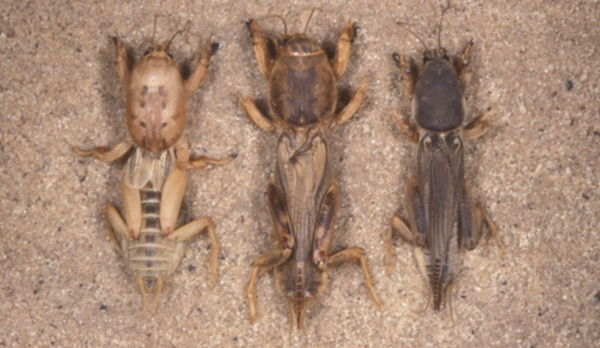Crickets are pretty nippy insects and if you try to catch them, it feels like they are “one jump ahead of you”. They are relatives of katydids and grasshoppers. Out of 2,400 species of crickets, the United States is home to 120 species. Many male crickets are known for musical chirping, which they produce by rubbing their front wings together. Now before we deep dive into what do crickets eat in the garden as well as in captivity, let’s explore briefly about these insects.
Crickets have worldwide distribution and they usually find a hiding place under plants in temperate or tropical habitats. These insects prefer living in marshes or swamps, where plants are plentiful. Chirping sounds of crickets are louder during warm nights than on freezing nights.
They hop with the help of their large hind legs. Most of them are active during the night and spend their daytime hidden under fallen logs, bark, curling leaves or cracks. While most crickets have wings, there are some crickets that cannot fly like wingless bush crickets. These tiny ant-loving species live in ant nests.

Three mole cricket species: shortwinged mole cricket, Neoscapteriscus abbreviatus (left); tawny mole cricket, Neoscapteriscus vicinus (center); southern mole cricket, Neoscapteriscus borellii (right). Photo © Lyle J. Buss. Image Source: University of Florida
A new study reveals that during a fight in an arena, male crickets tend to become more violent once they notice other crickets are around. In other words, they love audience (as much as we do!).
What Do Crickets Eat in the Wild
Since they aren’t picky eaters at all, they will snack on just about anything thanks to their powerful jaws. However, in most cases, crickets feed on both animal and plant matter. However, they are quite flexible in their diet and do not rely exclusively on natural diet. Depending upon the availability, they may also feed on organic foods.
Some cricket species are strictly herbivores. Such species nibble on the shoots of young plants, leaves, fruit and flowers, as well as on grasses and seedlings.
There are some species of crickets that have predatory diet such as eggs or larvae of invertebrates, small sap-sucking insects called greenfly (or aphids), scale insects, and also moulting insects.
Few species of crickets are scavengers and eat a wide variety of fungi, decaying plants, seedlings, and a wide range of organic remains.
Field crickets feed on a wide range of plants along pastures or roadsides. Besides, they are also found to eat dead insects, and even other crickets. Just like house crickets, if they move into any building or home, they feed on cotton, wool, silk, or woven materials. Last but not least; these insects also prefer feeding on a fabric if it is soiled by perspiration.
Sources & Further Reading:
Huber, Franz (1989). Cricket Behavior and Neurobiology. Cornell University Press. p. 28.
“Cricket Information”. University of Arizona
Britannica, The Editors of Encyclopaedia. “Cricket“. Encyclopedia Britannica, 20 Jun. 2019.
“Gryllidae” (On-line), Animal Diversity Web. Accessed March 25, 2021
Hahn, Jeffrey and Mark Ascerno. “Crickets“. University of Minnesota.
Christine, Dell’amore. “Crickets Act Differently When Others Are Watching“. National Geographic.
